Drink can
A drink can (or beverage can) is a metal container designed to hold a fixed portion of liquid such as carbonated soft drinks, alcoholic drinks, fruit juices, teas, herbal teas, energy drinks, etc. Drink cans are made of aluminium (75% of worldwide production)[1] or tin-plated steel (25% worldwide production). Worldwide production for all drink cans is approximately 370 billion cans per year worldwide.[1]
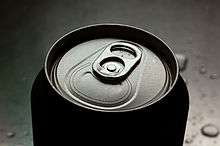
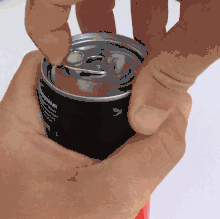
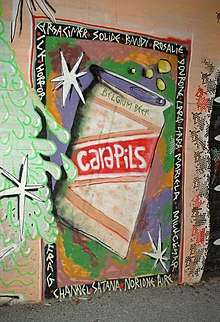
History
The first commercial beer available in cans began in 1935 in Richmond, Virginia.[2] Not long after that, sodas, with their higher acidity and somewhat higher pressures, were available in cans. The key development for storing drinks in cans was the interior liner, typically plastic or sometimes a waxy substance, that helped to keep the product's flavor from being ruined by a chemical reaction with the metal. Another major factor for the timing was the repeal of Prohibition in the United States at the end of 1933.
In 1935,[3] the Felinfoel Brewery at Felinfoel in Wales was the first brewery outside the US to commercially can beer. Prior to this time, beer was only available in barrels or in glass bottles. From this time, lightweight tin cans could be used. Felinfoel was a major supplier to British armed forces abroad in the Second World War - cans saved a great deal of space and weight for wartime exports compared to glass bottles, and did not have to be returned for refilling. These early cans did not have a pull tab, instead they had a crown cork (beer bottle top). All modern UK canned beer is descended from these small, early cans which helped change the drinking and beer-buying habits of the British public. From the 18th century until the early 20th century Wales dominated world tinplate production, peaking in the early 1890s when 80% of the world's tinplate was produced in south Wales.
Canned drinks were factory-sealed and required a special opener tool in order to consume the contents. Cans were typically formed as cylinders, having a flat top and bottom. They required a can piercer, colloquially known as a "church key", that latched onto the top rim for leverage; lifting the handle would force the sharp tip through the top of the can, cutting a triangular hole. A smaller second hole was usually punched at the opposite side of the top to admit air while pouring, allowing the liquid to flow freely.
In the mid-1930s, some cans were developed with caps so that they could be opened and poured more like a bottle. These were called "cone tops", as their tops had a conical taper up to the smaller diameter of the cap. Cone top cans were sealed by the same crimped caps that were put on bottles, and could be opened with the same bottle-opener tool. There were three types of conetops: high profile, low profile, and j-spout. The low profile and j-spout were the earliest, dating from about 1935. The "crowntainer" was a different type of can that was drawn steel with a bottom cap. These were developed by Crown Cork & Seal (now known as Crown Holdings, Inc.), a leading drink packaging and drink can producer. Various breweries used crowntainers and conetops until the late 1950s, but many breweries kept using the simple cylindrical cans.
The popularity of canned drinks was slow to catch on, as the metallic taste was difficult to overcome with the interior liner not perfected, especially with more acidic sodas. Cans had two advantages over glass bottles. First for the distributors, flat-top cans were more compact for transportation and storage and weighed less than bottles. Second for consumers, they did not require the deposit typically paid for bottles, as they were discarded after use. Glass-bottle deposits were reimbursed when consumers took the empties back to the store.
By the time the United States entered World War II, cans had gained only about ten percent of the drink container market; this was drastically reduced during the war to accommodate strategic needs for metal.
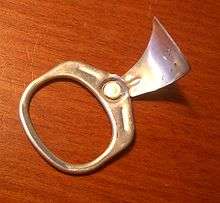
In 1959, the recyclable aluminum can was introduced to the market in a 7 oz. size by the Adolph Coors Company. Also in 1959, Ermal Fraze devised a can-opening method that would come to dominate the canned drink market. His invention was the "pull-tab". This eliminated the need for a separate opener tool by attaching an aluminium pull-ring lever with a rivet to a pre-scored wedge-shaped tab section of the can top. The ring was riveted to the center of the top, which created an elongated opening large enough that one hole simultaneously served to let the drink flow out while air flowed in. In 1959, while on a family picnic, Mr. Fraze had forgotten to bring a can opener and was forced to use a car bumper to open a can of beer. Thinking there must be an easier way, he later stayed up all night until he came up with the pull tab.[4] Pull-tab cans, or the discarded tabs from them, were also called "pop-tops" colloquially. Into the 1970s, the pull-tab was widely popular, but its popularity came with a significant problem, as people would frequently discard the pull-tabs on the ground as litter, or drop them into the can and risk choking on them. These problems were both addressed by the invention of the "push-tab". Used primarily on Coors Beer cans in the mid-1970s, the push-tab was a raised circular scored area used in place of the pull-tab. It needed no ring to pull up. Instead, the raised aluminium blister was pushed down into the can, with a small unscored piece that kept the tab connected after being pushed inside. Push-tabs never gained wide popularity because while they had solved the litter problem of the pull-tab, they created a safety hazard where the person's finger upon pushing the tab into the can was immediately exposed to the sharp edges of the opening. An unusual feature of the push-tab Coors Beer cans was that they had a second, smaller, push-tab at the top as an airflow vent—a convenience that was lost with the switch from can opener to pull-tab. The "push-tab" was introduced into Australia in the early 1980s and was locally known as "pop-tops".
The safety and litter problems were both eventually solved later in the 1970s with Daniel F. Cudzik's invention of the non-removing "Stay-Tab". The pull-ring was replaced with a stiff aluminium lever, and the removable tab was replaced with a pre-scored round tab that functioned similarly to the push-tab, but the raised blister was no longer needed, as the riveted lever would now do the job of pushing the tab open and into the interior of the can.
In 2008, an aluminium version of the crowntainer design was adopted for packaging Coca-Cola's Caribou Coffee drink. In 2004, Anheuser-Busch adopted an all-aluminium bottle for use with Budweiser and Bud Light beers.
Standard sizes
| Comparison chart of various standards | ||
|---|---|---|
| ml | imp fl oz | US fl oz |
| 1,000 | 35.2 | 33.8 |
| 568 | 20.0[nb 1] | 19.2 |
| 500 | 17.6 | 16.9 |
| 473 | 16.6 | 16.0[nb 2] |
| 440 | 15.49 | 14.88 |
| 375 | 13.2 | 12.7 |
| 355 | 12.5 | 12.0 |
| 350 | 12.3 | 11.8 |
| 341 | 12.0 | 11.5 |
| 330 | 11.6 | 11.2 |
| 320 | 11.3 | 10.8 |
| 250 | 8.8 | 8.5 |
| 237 | 8.3 | 8.0[nb 3] |
| 222 | 7.8 | 7.5 |
| 200 | 7.0 | 6.8 |
| 150 | 5.3 | 5.1 |
| ||
Capacity in countries
Various standard capacities are used throughout the world.
- Australia
In Australia the standard can size for alcoholic and soft drinks is 375 ml. Energy drinks are commonly served in 250 ml and 500 ml sizes.
- Brazil
In Brazil the standard can size is 330 ml.
- China
In China the most common size is 330 ml.
Can dimensions may be cited in metric or imperial units; imperial dimensions for canmaking are written as inches+sixteenths of an inch (e.g. "202" = 2 inches + 2 sixteenths).[5]
- Europe
In Europe the standard can is 330 ml, but since the 1990s 250 ml has slowly become common, along with 500 ml. It's often used for beer, cider and energy drinks.
In the UK, 440 ml is commonly used for lager and cider.
In Austria, energy drinks are usually sold in sizes of 200 to 330 ml.
- Hong Kong
In Hong Kong most cans are 330 ml.
- India
In India standard cans are 250 ml.
- Indonesia
Indonesia introduced 320 ml cans for domestically produced beer in 2018. Carbonated soft drink cans are typically 330 ml.
- Japan
In Japan the most common sizes are 350 ml and 500 ml, while larger and smaller cans are also sold.
- Malaysia and Singapore
In Malaysia, beer cans are 320 ml. For soft drinks in both Malaysia and Singapore, the most commonly found cans are 300 ml for non-carbonated drinks and 325 ml for carbonated drinks. Larger 330 ml/350 ml cans are limited to imported drinks which usually cost a lot more than local ones.
- Middle East
In the Middle East standard cans are 330 ml.
- New Zealand
In New Zealand the standard can size is 355 ml, although Coca-Cola Amatil changed some of its canned drinks to 330 ml in 2017.[6]
- North America
In North America, the standard can size is 12 US fl oz or 355 ml. The US standard can is 4.83 in or 12.3 cm high, 2.13 in or 5.41 cm in diameter at the lid, and 2.6 in or 6.60 cm in diameter at the widest point of the body. Also available are 16 US fl oz or 473 ml cans (known as tallboys), and 18 US fl oz or 532 ml
In Canada, the standard size was previously 10 Imperial fluid ounces (284 ml), later redefined and labeled as 280 ml in 1980. This size was commonly used with steel drink cans in the 1970s and early 1980s. However, the US standard 355 ml can size was standardized in the 1980s and 1990s upon the conversion from steel to aluminium. Some drinks, such as Nestea, are sold in 341 ml cans.
In Quebec, a new standard for carbonated drinks has been added, as some grocery stores now only sell cans of all major carbonated drinks in six-packs of 222 ml cans. Many convenience stores also began selling "slim cans" with a 310ml capacity in 2015.
- Pakistan
In Pakistan the most common sizes are 250 ml and 330 ml, and 200 ml cans are also sold.
- South Africa
South African standard cans are 330 ml (reduced in the early 2000s from the up-until-then ubiquitous 340 ml) and the promotional size is 440 ml. There is also the 500 ml can. A smaller 200 ml can is used for "mixers" such as tonic or soda water. It has a smaller diameter than the other cans. In September 2018, a 300 ml can was introduced as an alternative to the 330 ml can in a continued effort to reduce the amount of sugar consumed in soft drinks.
- South Korea
250 ml cans are the most common for soft drinks, but when accompanying take out food (such as pizza or chicken), a short 245 ml can is standard. Recently, some 355 ml cans which are similar to North American cans are increasingly available, but are limited mostly to Coca-Cola and Dr Pepper, and beer cans are available in 500 ml.
- Thailand
Singha beer uses 320 ml cans for domestic sales and 330 ml cans for exports.[7]
Composition
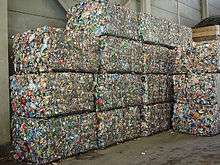
Most metal drink cans manufactured in the United States are made of aluminium,[8] whereas in some parts of Europe and Asia approximately 55 percent are made of steel and 45 percent are aluminium alloy. Steel cans often have a top made of aluminium. The aluminium used in United States and Canada are alloys containing 92.5% to 97% aluminium, <5.5% magnesium, <1.6% manganese, <0.15% chromium and some trace amounts of iron, silicon and copper according to MSDS from aluminium producer Alcoa.[9] Alloys used include 3004, 3105, or other 3xxx/5xxx series aluminium.[10]
An empty aluminium can weighs approximately one-half ounce (14 g). There are 34 empty 12 ounce aluminium cans to a pound or 70 to a kilogram.[11]
In many parts of the world a deposit can be recovered by turning in empty plastic, glass, and aluminium containers. Scrap metal dealers often purchase aluminium cans in bulk, even when deposits are not offered. Aluminium is one of the most cost-effective materials to recycle. When recycled without other metals being mixed in, the can–lid combination is perfect for producing new stock for the main part of the can—the loss of magnesium during melting is made up for by the high magnesium content of the lid. Also, reducing ores such as bauxite into aluminium requires large amounts of electricity, making recycling cheaper than producing new metal.
Aluminium cans are coated internally to protect the aluminium from oxidizing. Despite this coating, trace amounts of aluminium can be degraded into the liquid, the amount depending on factors such as storage temperature and liquid composition.[12][13] Chemical compounds used in the internal coating of the can include types of epoxy resin.[14]
Filling cans
Cans are filled before the top is crimped on by seamers. The filling and sealing operations need to be extremely fast and precise. The filling head centers the can using gas pressure, purges the air, and lets the drink flow down the sides of the can. The lid is placed on the can, and then crimped in two operations. A seaming head engages the lid from above while a seaming roller to the side curls the edge of the lid around the edge of the can body. The head and roller spin the can in a complete circle to seal all the way around. Then a pressure roller with a different profile drives the two edges together under pressure to make a gas-tight seal. Filled cans usually have pressurized gas inside, which makes them stiff enough for easy handling. Without the riveted tab the scored section of the can's end would be impossible to lift from the can.
Can filling lines come in different line speeds from 15,000 cans per hour (cph) up to 120,000 cph or more, all with different levels of automation. For example lid feeding alone starts with manual debagging onto a simple v-chute connected to the seamer up to fully automated processen with automatic debagging and lid feeding of lids combined with automatic roll depalletizers for filling debaggers by robots.
Fabrication process
Modern cans are generally produced through a mechanical cold forming process that starts with punching a flat blank from very stiff cold-rolled sheet. This sheet is typically alloy 3104-H19 or 3004-H19, which is aluminium with about 1% manganese and 1% magnesium to give it strength and formability. The flat blank is first formed into a cup about three inches in diameter. This cup is then pushed through a different forming process called "ironing" which forms the can. The bottom of the can is also shaped at this time. The malleable metal deforms into the shape of an open-top can. With the sophisticated technology of the dies and the forming machines, the side of the can is significantly thinner than either the top and bottom areas, where stiffness is required.
Plain lids (known as shells) are stamped from a coil of aluminium, typically alloy 5182-H48, and transferred to another press that converts them to easy-open ends. This press is known as a conversion press which forms an integral rivet button in the lid and scores the opening, while concurrently forming the tabs in another die from a separate strip of aluminium.
Opening mechanisms
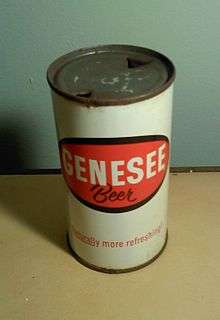
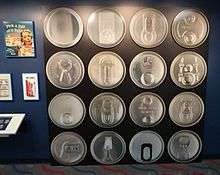
Early metal drink cans had no tabs; they were opened by a can-piercer or churchkey, a device resembling a bottle opener with a sharp point. The can was opened by punching two triangular holes in the lid—a large one for drinking, and a second smaller one to admit air.
As early as 1922, inventors were applying for patents on cans with tab tops, but the technology of the time made these inventions impractical.[15] Later advancements saw the ends of the can made out of aluminium instead of steel.
Cans are usually in sealed paperboard cartons, corrugated fiberboard boxes, or trays covered with plastic film. The entire distribution system and packaging need to be controlled to ensure freshness.[16]
Pop-tab
Mikolaj Kondakow and James Wong of Thunder Bay, Ontario, Canada invented the pull tab version for bottles in or before 1951 (Canadian patent 476789).[17] In 1962, Ermal Cleon Fraze (1913–1989)[18] of Dayton, Ohio, United States, invented the similar integral rivet and pull-tab version (also known as ring pull in British English), which had a ring attached at the rivet for pulling, and which would come off completely to be discarded. He received US Patent No. 3,349,949 for his pull-top can design in 1963 and licensed his invention to Alcoa and Pittsburgh Brewing Company, the latter of which first introduced the design on Iron City Beer cans. The first soft drinks to be sold in all-aluminium cans were R.C. Cola and Diet-Rite Cola, both made by the Royal Crown Cola company, in 1964.
The early pull-tabs detached easily. In 1976, the Journal of the American Medical Association noted cases of children ingesting pull-tabs that had broken off and dropped into the can.[19]
Full-top pull-tabs were also used in some oil cans and are currently used in some soup, pet food, tennis ball, nuts, and other cans.
Stay-on-tab
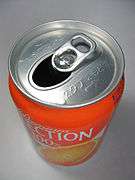
In 1975, Daniel F. Cudzik, an engineer with Reynolds Metals, filed a design patent application for an "End closure for a container".[20] This later became known as a "Sta-Tab". When the Sta-Tab launched in 1975, on Falls City beer and, quickly, other drinks, there was an initial period of consumer testing and education. Cudzik later received patents for this "Easy Open Wall" (US 3967752, issued 1976-07-06 US 3967753, issued 1976-07-06). The validity of these patents was upheld in subsequent litigation.[21]
The similarly designed "Easy-open ecology end" was invented by Ermal Fraze and Omar Brown. Its patent application was also filed in 1975. This design, like Cudzik's, uses a separate tab attached to the upper surface as a lever to depress a scored part of the lid, which folds underneath the top of the can and out of the way of the resulting opening, thus reducing injuries and roadside litter caused by removable tabs.[22]
Such "retained ring-pull" cans supplanted pull-off tabs in the United Kingdom in 1989 for soft drinks and 1990 for alcoholic drinks.[23]
Wide mouth
One of the more recent modifications to can design was the introduction of the "wide mouth" can in the late 1990s.[24] The American Can Company, now a part of Rexam,[25] and Coors Brewing Company have owned wide mouth design patent (number D385,192)[26] since 1997. Other companies have similar designs for the wide mouth. Ball Corporation's from 2008 has a vent tube to allow direct airflow into the can reducing the amount of gulps during the pour.[27]
Press button can
One variation was the press button can,[28] which featured two pre-cut buttons—one small and one large—in the top of the can sealed with a plastic membrane. These buttons were held closed by the outward pressure of the carbonated drink. The consumer would open the can by depressing both buttons, which would result in two holes. The small hole would act as a vent to relieve internal pressure so the larger button could then be pressed down to create the hole used for consuming the drink. Consumers could also easily cut themselves on the edges of the holes or get their fingers stuck.
Press button cans were used by Pepsi in Canada from the 1970s to 1980s and Coors in the 1970s. They have since been replaced with pull tabs. Used in Australia, locally known as "pop-tops", for soft drinks during the early 1980s. However, Heineken Brewery did bring back press- or push button cans on the market in Europe as a short lived marketing strategy in the 1990s.
Full aperture end
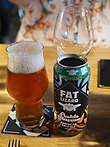
Another variation on the drink can is the "full aperture end", where the entire lid can be removed – turning an aluminium can into a cup. Crown Holdings first designed the "360 End"[29] for use by SABMiller at the 2010 FIFA World Cup in South Africa.[30] It has been used by Anheuser-Busch InBev in China[31] and Brazil[32] and by the Sly Fox Brewing Company[33] in the United States.
Resealable lid
Another variation on the drink can is to have a resealable lid. A version patented by Cogito Can in France has been used by Groupe Casino, the French grocery chain for its private label energy drink.
Resealable lids are currently very often used for premium canned products like water and energy drinks.
Design
Most large companies serve their beverages in printed cans, where designs are printed on the aluminum and then crafted into a can. Alternatively, cans can be wrapped with a plastic design,[34] mimicking the printed can but allowing for more flexibility than printed cans.[35] A modern-day trend in craft alcohol is to design stickers to put on cans, allowing for smaller batches and quick changes for new flavors.[36]
Collecting
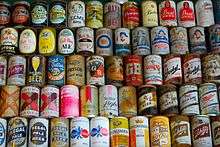
Beer can collecting was a minor fad in the late 1970s and 1990s. However, the hobby waned rapidly in popularity. The Beer Can Collectors of America (BCCA), founded in 1970, was an organization supporting the hobby, but has now renamed itself Brewery Collectibles Club of America to be more modern.[37]
As of late 2009, membership in the Brewery Collectibles Club of America was 3,570, down from a peak of 11,954 in 1978. Just 19 of the members were under the age of 30, and the members' average age had increased to 59.[38]
See also
- Beer Can Museum
- Beer Can Printing
- Beer koozie
- Beverage-can stove
- Self-heating can
- Six pack rings
- Widget (beer)
.svg.png)
Notes
- "The Canmaker FAQ". Canmaker.com. Retrieved 2012-08-07.
- Maxwell, DBS (1993). "Beer Cans: A Guide for the Archaeologist". Historical Archaeology. 27 (1): 95–113. JSTOR 25616219.
- Prior, Neil (2015-07-12). "Llanelli's Felinfoel brewery pioneered beer in cans". BBC News (South West Wales). Retrieved 2017-04-09.
- Narvaez, Alfonso A. (1989-10-28). "E. C. Fraze, 76 - Devised Pull Tab". NYTimes.com. Retrieved 2017-04-09.
- "2-piece DWI Can Dimensions". Sencon.com. Retrieved 2012-08-07.
- @tnichss, Tess Nichol Reporter, NZ Herald tess nichol@nzherald co nz (2017-09-21). "Coke responds to can shrink story, says price decrease recommended". NZ Herald. ISSN 1170-0777. Retrieved 2017-11-01.
- "Our Beer". Retrieved 2020-06-15.
- Turner, Terence (2001). Canmaking For Can Fillers. Boca Raton: CRC Press. p. 23. ISBN 978-0-8493-9787-5.
- "Alcoa Inc. - primary aluminium (aluminium) and fabricated aluminium products". Alcoa.com. Retrieved 2012-08-07.
- "ALCOA - RIGID PACKAGING DIVISION SPECIFICATION FOR PURCHASE OF RECLAIMED SCRAP INGOT (RSI) INGOT/SOW" (PDF). Alcoa. Archived from the original (PDF) on 2013-08-29. Retrieved 2014-01-24.
- "Amount Of Empty 12 OZ Cans In A Pound - Scrap, Junk & Salvage Yard Search Engine". Junkmetal.com. 2010-11-02. Retrieved 2017-04-09.
- Vela, M.; Toma, R. B.; Reiboldt, W.; Pierri, A. (1998). "Detection of aluminium residue in fresh and stored canned beer". Food Chemistry. 63 (2): 235–037. doi:10.1016/S0308-8146(97)00236-7.
- Lopez, F.; Cabrera, C.; Lorenzo, M. L.; López, M. C. (2002). "Aluminium content of drinking waters, fruit juices and soft drinks: contribution to dietary intake". The Science of the Total Environment. 292 (3): 205–213. doi:10.1016/S0048-9697(01)01122-6. PMID 12146520.
- "Precoating of aluminium can sheet - Patent 3832962". www.freepatentsonline.com. Retrieved 2009-07-20.
- "Keglined.com". Pssht.com. Retrieved 2012-08-07.
- Singh, S. P.; Gorzynski (July 1989). "Effect of Vibration as a Cause of Leakage in aluminium Beer Cans in Palletized Loads". J. Testing and Evaluation. 26 (4).
- Kondakow, Mikolaj (1951-09-11). "Patent CA476789: Crimped cap removers". Canadian Patents Database. Retrieved 2017-10-04.
- Find A Grave
- Burrington, JD (1976). "Aluminium "pop tops". A hazard to child health". JAMA. 235 (24): 2614–7. doi:10.1001/jama.1976.03260500030022. PMID 946866.
- "Patent US D244915 - End closure for a container - Google Patents". Retrieved 19 March 2015.
- Reynolds Metals Co. v. Continental Group, Inc., 525 F. Supp. 950, July 6, 1981
- "Patent US4030631 - Easy-open ecology end - Google Patents". Retrieved 2014-01-24.
- "History of the can" (PDF). Can Makers. Archived from the original (PDF) on 2015-09-22. Retrieved 2012-08-07.
- Patton, Phil (1997-11-27). "Public Eye; Wide-mouth design: less glug in beer, more chug in Mountain Dew". The New York Times.
- Cowell, Alan (2000-04-04). "COMPANY NEWS; REXAM TO BUY AMERICAN NATIONAL CAN GROUP". The New York Times.
- "United States Patent: D385192". Patft.uspto.gov. Retrieved 2013-10-05.
- paywalled page
- "Press Button Can — A Brief History of Flat Top Beer Cans". Complex. 2012-06-27. Retrieved 2013-10-05.
- "360 end".
- "Crown History | Crown Holdings, Inc". Crowncork.com. Retrieved 2013-10-05.
- "AB InBev and Crown Say "Gan Bei!" to a New Packaging Format | Crown Holdings, Inc". Crowncork.com. 2012-10-09. Retrieved 2013-10-05.
- Cohen, Jim. "Brazil Transforms Beer Can into Beer Cup". Beer Universe. Beer Universe, Inc. Retrieved 18 March 2014.
- "Sly Fox Beer Opens Up Flavor and Aroma with the 360 Lid | Sly Fox Beer Phoenixville & Pottstown Pennsylvania". Slyfoxbeer.com. 2013-03-25. Archived from the original on 2013-10-12. Retrieved 2013-10-05.
- "Canning Your Brands: Shrink Wraps & Sticker Labels". 2018-08-07.
- "Beer can labels".
- "One Can, Many Beers".
- "Brewery Collectibles Club of America - Club History". Archived from the original on 2011-08-26.
- Kesmodel, David (December 9, 2009). "Behold the Beer Can, Its Beauty Faded in the Eyes of the Young". The Wall Street Journal.
References
- Yam, K. L., "Encyclopedia of Packaging Technology", John Wiley & Sons, 2009, ISBN 978-0-470-08704-6
- Soroka, W., Fundamentals of Packaging Technology, IoPP, 2002, ISBN 1-930268-25-4
External links
| Wikimedia Commons has media related to Beverage cans. |